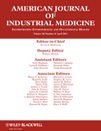Health impact of pneumoconiosis in Mongolia: Estimation of losses in life expectancy and quality adjusted life expectancy†
Disclosure Statement: No competing financial interests exist.
Abstract
Objective
To estimate the life expectancy (LE), quality-adjusted life expectancy (QALE), and their losses, in patients with pneumoconiosis in Mongolia.
Methods and Materials
All patients (n = 432) diagnosed with occupational pneumoconiosis during 1986–2006 were recruited from the registry of the National Research Center of Occupational Diseases, which was linked to the National Mortality Registry of Mongolia to obtain the survival function. We simulated age and gender matched referents group based on the life table in 2000. The survival ratio between patients and referents was used to extrapolate and calculate the LE. The average expected years of life loss (EYLL) of pneumoconiosis were calculated as the mean survival difference between patients and referents. We adopted utility values for workers with pneumoconiosis and multiplied them with the survival function to estimate the QALE, which was then used to calculate the loss of QALE.
Results
The life expectancy and EYLL of a patient with pneumoconiosis were 18.1 and 9.5 years respectively. QALE and loss of QALE were 15.1 and 12.5 QALYs (quality-adjusted life years), respectively, indicating a health gap of 45%.
Conclusion
The health inequality suffered by miners in Mongolia must be addressed through prevention, including exposure monitoring and control, early diagnosis and case management and rehabilitation of pneumoconiosis. Am. J. Ind. Med. 54:285–292, 2011. © 2011 Wiley-Liss, Inc.




